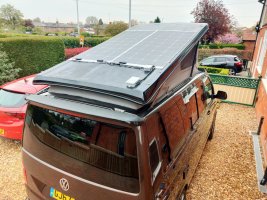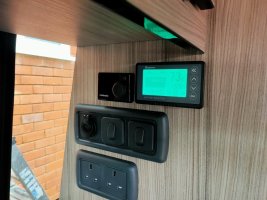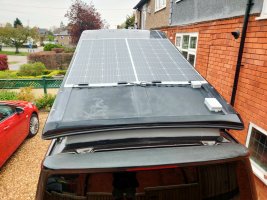Got my panels on the roof finally, not a lot of room left up there as what I need and what I could actually squeeze up there were two different parameters and me being a little bloke had to compensate.
Anyway they're running, I think and possibly producing between 50 and 70 watts on a pretty dull day on the north side of the house in the shade.
I'm a little bit confused as due to my Luddite acceptance of apps and Blueteeth the only indication of charging I've got is from the Renogy shunt which I've included here and while it has the slow strobing of the display to indicate "stuff" is going on the arrows are facing up as if charge was leaving the battery however the indicated battery content has increased by 2Ah in the last hour.
Panels are 175 watt Renogy and I've had to shave about 9mm off of one side and overlap the original margin down the centreline of the roof, the butchery leaves about 10mm blank before the conductor tracks and actual cells and this new edge has been sealed with clear window grade solvent based sealant so might last at least one winter.
The joint boxes are a bit fugly but the panels had to be connected in parallel to keep below the upper voltage limit on the MPPT part of the Renogy DCC50S of 20 ish volts DC.
This is on a SWB van and on a roof peppered with stainless bolt heads for hardware underneath so as ever a compromise if you want to keep the panels as flat to the roof as possible.



Anyway they're running, I think and possibly producing between 50 and 70 watts on a pretty dull day on the north side of the house in the shade.
I'm a little bit confused as due to my Luddite acceptance of apps and Blueteeth the only indication of charging I've got is from the Renogy shunt which I've included here and while it has the slow strobing of the display to indicate "stuff" is going on the arrows are facing up as if charge was leaving the battery however the indicated battery content has increased by 2Ah in the last hour.
Panels are 175 watt Renogy and I've had to shave about 9mm off of one side and overlap the original margin down the centreline of the roof, the butchery leaves about 10mm blank before the conductor tracks and actual cells and this new edge has been sealed with clear window grade solvent based sealant so might last at least one winter.
The joint boxes are a bit fugly but the panels had to be connected in parallel to keep below the upper voltage limit on the MPPT part of the Renogy DCC50S of 20 ish volts DC.
This is on a SWB van and on a roof peppered with stainless bolt heads for hardware underneath so as ever a compromise if you want to keep the panels as flat to the roof as possible.













